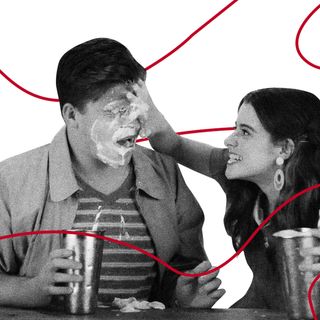Our prehistoric ancestors from the stone age may have been hallucinating while they created paintings in deep, dark parts of caves, according to a new study.
What’s interesting is these out-of-body experiences might have been induced on purpose, research suggests. The present study aligns with previous theories that posited ancient cave art was created by people in an altered state of mind.
Published in Time and Mind: The Journal of Archaeology, Consciousness and Culture, the study explored narrow, dark passageways in parts of France and Spain that are home to a large number of cave paintings, dating between 40,000 and 14,000 years old. The caves were situated on high altitudes, and the experience of existing in closed spaces with low oxygen levels could have induced hypoxia in people — causing headaches, shortness of breath, confusion, and restlessness. Simultaneously, hypoxia also increases the production of dopamine, or ‘happy hormones,’ in the brain, resulting in hallucinations and out-of-body experiences.
The study also cites experiences of speleologists — scientists who study caves — who have reported experiences of hallucinations in deep underground caves in the past. “It is tempting to slip away from this by switching off the light [in this case, headlamps], and entering a state of peaceful nothingness that normally is not reached by living persons without the use of strong mind-altering drugs,” Hein Bjartmann Bjerck, a professor of archaeology from the Norwegian University of Science and Technology, who wasn’t part of the present study, wrote about his cave expeditions.
“It appears that [prehistoric] people barely used the interior of deep caves for daily, domestic activities. Such activities were mostly performed at open-air sites, rock-shelters, or cave entrances,” the study notes. This has led the researchers to speculate that the hallucinations weren’t accidents, but were, in fact, deliberate. They posited that it was “a conscious choice, motivated by an understanding of the transformative nature of an underground, oxygen-depleted space.”
Related on The Swaddle:
One of the Most Extensive Collections of Prehistoric Rock Paintings Discovered in the Amazon
To prove the impact of hypoxia in these caves, researchers used computer simulations to calculate the levels of oxygen concentration in the narrow passageways; the results suggest that oxygen levels dropped from 21%, which is the natural atmospheric level, to 18%, a level at which mild hypoxia could be induced– in just 15 minutes. Especially so, since torchlights, which would have been a necessity to navigate, leave alone paint, inside the caves, would have catalyzed the oxygen depletion by burning it up. The simulations further suggested that after spending over two hours there with burning torches, the levels dropped to 11%, which can induce severe hypoxia.
However, the idea that ancient cave paintings were inspired by altered states of consciousness has been around since at least the 1980s. “Archaeologists have long been fascinated over what exactly compelled ‘cavemen’ to produce these enigmatic paintings… certain experts have argued that prehistoric painters may have produced their art under the influence of “altered states of consciousness,” Paul Pettitt, professor of archaeology at Durham University in the U.K., who wasn’t involved in the study, wrote in The Conversation.
Different studies from 2011, 2013, and 2020 have suggested that cavemen may have been under the influence of hallucinogens like magic mushrooms or datura, which occur naturally in the environment. The present study is just the latest to lend greater credence to the theory that ancient cave paintings were produced by painters, who were in all likelihood, ‘high.’
While the theory appears to be gaining momentum rapidly, historians like Petitt believe it ends up doing a disservice to the imagination and legacy of our prehistoric ancestors. But commenting on the present study, Petitt does admit that “it’s difficult to falsify the new hypothesis scientifically.”




